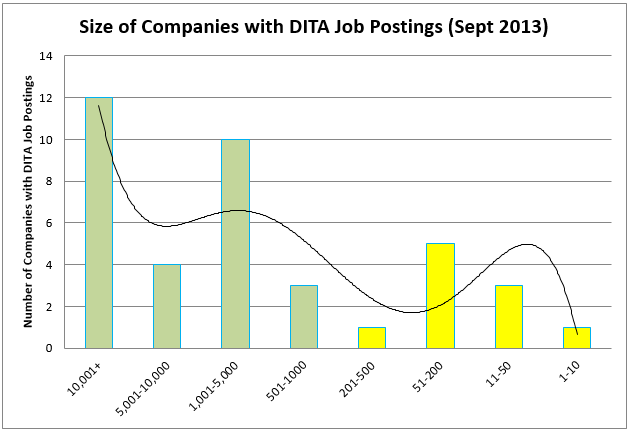
One other thing that emerged from the job posting information was that it matches a pattern I have seen before, suggesting that DITA is a “one size fits all” solution. The same pattern is seen here, with very-large, large and mid-size firms being those who are seeking people with DITA experience the most:

As you can see there is a continuum of DITA usage, with firms of all sizes seeking people with DITA experience, but with three peaks, which occur with the very large (10,000+ employees), large (1,001-5,000 employees) and medium-sized (51-200 employees) firms. I would be interested in hearing from others as to why they think this pattern exists, and here are my thoughts:
- Small firms benefit from the more efficient processes (content reuse, de-siloed writers) that DITA has to offer, and those benefits are more pronounced with small to mid-sized firms.
- Large and very-large firms reap the same benefits in addition to others (reduced localization costs, content reuse across a wider range of products, exchanging DITA-based content with partners) that come with scale.
In these cases it just “makes sense” to do things using DITA. I suspect that very small firms (1-10 employees) adopt DITA because of the relatively low-cost of the tools involved, but I have a harder time explaining the relatively low adoption pattern that exists with medium-to-large (201-1000 employee) and medium-large (5,001-10,000) firms. I am guessing that firms at these sizes are themselves going through a maturation process where old-school/brute-force methods of doing documentation still hold sway. If anyone has any other thoughts on this why this reoccurring pattern exists, please leave your comments below!
So Where is DITA Now and Where is it Going?
DITA continues to be a sought-after skill among technical writers, with increasing demand. While there are other technical writing standards out there, it is by far the most popular, and may have help kill off DocBook. The industry as a whole appears to have entered a more mature phase, though there are still a sizable number of firms seeking to migrate to DITA, so there are still jobs out there for people looking to help with the transition, but that type of opportunity is getting smaller over time. DITA still dominates in the software/IT sectors, but it is increasingly seeing usage outside of those two “core” sectors, and the relative sizes of firms looking for those with DITA experience follows a continuing trend.
Where will DITA adoption be a year from now? While I hesitate to pull out my crystal ball (after all, those things are fragile) I think I can safely make the following predictions based on the trends observed:
- DITA adoption will continue to grow slowly but steadily
- More firms will enter the mature phase of DITA adoption
- The DITA tool market will likely begin to see signs of consolidation with select players taking the lead, though there is still room for firms who can bring strong and compelling products to DITA authors
- DITA becoming the de facto choice for documentation within software/IT firms
- Continued growth of DITA outside of its software/IT core.
Let’s meet back in a year and see how many of these predictions pan out. In the meantime, keep watching this space for more DITA news and analysis.
Yellow Pencil (www.yellowpencil.com) provides DITA training services along with information architecture and content strategy services for firms looking to move to structured content for their technical writing and web content teams.

Killing off docbook? Dream on Keith
I think it is safe to say that DocBook is not getting any additional traction in the marketplace, and that its influence in the tech writing world is waning. That’s not to say that there won’t be firms using DocBook for years to come, but that the user base in the States (according to tech writer job postings on Indeed.com) seems to be very small (roughly x10 less) when compared to DITA, and significantly lower than both SGML and S1000D. If I were a tech writer looking at the job market right now, DocBook would be at the bottom of the list in terms of learning priorities, since there appears to be so few firms hiring for that type of experience.
Interesting data. I wouldn’t be surprised if the fluctuations in the graph are caused simply by the small sample size: the data reflects only 39 companies, total, with DITA job postings. I’d also be curious to see a mapping to the total number of companies by size. It may be that the “spike” in DITA adoption in the 1001-5000 is just a reflection of the fact that a lot of companies are in that size range.
All of that notwithstanding, I think your conclusions — everything in the “So Where is DITA Now and Where is it Going?” section — are pretty much on target. Demand for DITA skills is increasing. There will be work for people who are willing to help with DITA conversion (and it’ll probably continue for longer than you think).
Finally, I hope you’re right that more firms will enter the mature phase of DITA adoption. Because more specialized authoring skills are needed to reach the higher points in the DITA maturity model, I’m afraid that a lot of companies will be content to stop at the middle points. I recently wrote about this, and got some great feedback in the comments.
True. The margin of error for these figures can be significant. The trends over time appear to be steady though, assuming no major change in the number of job postings that get collated by Indeed.com. What I find particularly interesting are the fluctuations in things like requests for MS Office experience. Another more disturbing trend I am planning to investigate further is the hint that the overall tech writing job market in the States may be shrinking…
It really does seem that we are entering a more mature phase of DITA use, and honestly it’s about time! 😉 Agreed that we will likely see ongoing conversion efforts going on for years to come as well, though I advise clients that they should only convert content that they are most likely to use going forward — there is little advantage in converting legacy content over to DITA (though there again the edit pass alone may be worth it, at least for the client’s users!)
Nice blog post btw, and I wish I had seen Joe Gelb’s presentation! Agreed that any DITA conversion efforts relies strongly on the quality of the content being transformed, and that GIGO rules all to often applies.
That’s disturbing, yes, but not altogether surprising. I’ll be very interested to see what your investigation turns up.
Interesting flash poll, Keith. Very ingenious of you to pull that info out of LinkedIn.
We are also very interested in knowing more about where we’re at and where the information development community is going. easyDITA is doing an annual poll that gets at some of these same questions. We had about 200 people take it last year – a pretty good sample size, re: Larry’s point, though probably skewed towards DITA adopters. We are hoping for more this year.
Take the poll here: https://www.surveymonkey.com/s/BYXFVZ6
All participants will get a copy if the results.
Get last year’s results here: http://goo.gl/2vsYR4
After looking at it I have to disqualify myself from responding to that survey, since as a consultant the actual amount of “publishing” I/we do is minimal compared to the people are trying to target, and would likely skew your results. In other words I don’t really “fit”. 😉
Having said that how long is this survey running for?